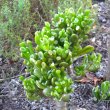| Botanical Name |
|
| Family |
Crassulaceae - The crassula family. |
| Pronunciation |
|
| Common Name(s) |
English: Spoon jade; Shrek Plant; Gollum Fingers
|
| Plant Group |
- Succulent A plant having fleshy stems or leaves often adapted to dry conditions.
|
| Plant Size |
- Medium to Large
| Tree | 15m to 20m |
| Shrub | 2m to 3m |
| Perennial/ground cover | 60cm to 75cm |
| Bulb | 60cm to 1m |
| Succulent | 60cm to 1m |
|
| Position |
- Light or Dappled Shade Found below trees with sparse, open foliage. Ideal for the protection of herbaceous plants.
- Partial Shade The area is in shade for part of the day and in full sun for part of the day.
- Sun The area is in full sun for all or most of the day, all year round.
|
| General Information |
- Drought Tolerance: High The plant is well adapted to arid conditions; it can survive long periods of drought and high temperatures without extra water.
- Evergreen Plants that have leaves all year round.
- Frost: Half-hardy The plant is able to survive low temperatures and some frost but requires protection against severe frost.
- Water Wise Plant species originating from low rainfall regions that require less water to survive and thrive than other plant species.
|
| Specific Information |
Crassula ovata 'Gollum' is a hybrid crassula. It is a small, branched, shrubby, erect succulent, that can grow up to 50-80 cm tall by 30-60 cm wide. It has a stout succulent, branching trunk and tubular shaped, glossy green leaves tipped with a "suction cup".
Crassula 'Gollum' is great for container culture and Bonsai cultivation as the trunk becomes very thick with age and develops interesting patterns.
|
| Ad Break |
|
| Flowers |
| Description |
tiny star flowers in tight round bunches
|
| Season |
- Winter Plants will seldom bloom for the entire season as given in the list, but should flower during a period within these parameters.
|
| Colour |
|
| Growth Rate |
- Moderate Specifying growth rate can be very misleading as there is considerable variation of growth rate depending on type and species of plant, available water, supplementary feeding, mulching and general care, as well as the plants suitability and adaptability to the garden environment.
|
| Plant Uses |
- Container Trees, shrubs and ornamental species that can adapt to growing in a restricted environment.
- Edging A low growing plant that provides softness or definition to the edges of a bed or walkway.
- Filler Either a fast growing tree or shrub used temporarily to fill in an area while the permanent plants grow to a desired size, or a plant used to fill gaps in borders or beds.
- Pot Plant A plant that needs a protected environment on a patio or indoors.
- Rock Garden An area constructed of larger rocks, arranged naturally, to emphasise the use of stones as a main element. Generally plants used do not need a lot of care.
- Suitable for smaller gardens Such plants do not have invasive root systems, remain small or controllable and can often be grown in containers.
- Wild Garden An indigenous garden planted for the benefit of wildlife and birds. Provides food, water, a variety of mini-biomes and no poisonous chemicals are used.
|
| Distribution and Habitat |
|
| Planting Suggestions |
This plant enjoys a bit of shade and grows well if given compost, watered a little more often than most succulents and is well mulched. Protect from frost.
|
| Medicinal Uses |
|
| Ad Break |
|






Discuss this plant
Share knowledge, ask a question or give an experience.